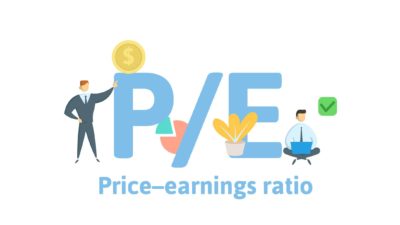The price/earnings (p/e) ratio is one of the most commonly used investing metrics.
There are lots of different ways to evaluate shares. You can look at the share price, the market capitalisation, the net profit, the dividend yield, the net tangible assets (NTA), the return on equity (ROE), the (free) cashflow and so on.
Different sized shares make different amounts of profit. How are you supposed to decide whether Commonwealth Bank of Australia (ASX: CBA) or Telstra Corporation Ltd (ASX: TLS) is cheaper?
The price/earnings ratio allows investors to try to compare different businesses based on how expensive they are compared to their earnings, even if they're from different industries and there are big market capitalisation differences.
How the price/earnings ratio works
The price/earnings ratio will tell you what multiple the current share price is compared to the earnings.
I'll try to give you an easy example so you can get your head around it. Imagine there's a café or shop that makes $100,000 of profit a year after paying for all expenses and costs. How much would you buy that business for? Assuming the business is going to be profitable for the foreseeable future, you'd probably pay more than $100,000. If you'd be willing to pay $300,000 then the business would have a price/earnings ratio of 3.
If that shop had lots of growth potential then perhaps you'd be willing to pay $500,000 or maybe even $1 million. That would be a p/e ratio of 5 or 10.
With big ASX shares like Telstra or Macquarie Group Ltd (ASX: COH), you can do the same sort of calculation. For example, in FY20 Macquarie made $7.645 of diluted earnings per share and it currently has a share price of $122, which translates to a price/earnings ratio of 16. This could also be described as 16x FY20's earnings.
How to compensate for faster-growing businesses
It starts getting tricky when you try to factor in the growth of a business. You could have one business with a FY20 p/e ratio of 20 and another with a FY20 p/e ratio of 30. One looks a lot more expensive than the other on this year's earnings.
But what if the second business is projected to double its profit in FY21 and the first doesn't grow profit at all? Compared to FY21's future earnings, the first business has a forward p/e ratio of 20 and the second has a forward p/e ratio of 15. The second business now looks cheaper.
If a business is growing at a good pace then you need to think about the estimated earnings of future years, not just the current year.
The positives of using the price/earnings ratio
I like how universal the p/e ratio can be. You can use it to compare a $100 billion giant and a small $100 million company.
The price/earnings ratio is easy to calculate. All you need is the share price and the earnings, which is available in the annual report. For future earnings you'll have to find an earnings projection or do some estimates yourself, which can be tricky.
Investors should focus on (long-term) profitability, so it's good to look at a metric that compares profitability of different shares.
The negatives
However, the p/e ratio can be simplistic at times in my opinion.
The accounting profit, and therefore the p/e ratio, can give an impression of excessive profitability. Depreciation is one of the worst types of expenses, the money goes out of the door whilst the deduction takes several years to be fully recognised. Some businesses may end up (legitimately) spreading out the cost of depreciation, which boosts near-term profit. There are some businesses that just fully expense things upfront in their accounts – I respect these companies.
Also, with some businesses you may see revenue recognised quite a long time before the cash is actually received into the bank. There are risks with this. It's important to look at the ongoing cash conversion. Indeed, some investors just prefer to look at the operating cashflow or the free cashflow rather than the accounting profit.
If you just focus on the p/e ratio you may miss cash generative businesses. Some businesses like Transurban Group (ASX: TCL) and Sydney Airport Holdings Pty Ltd (ASX: SYD) have high annual non-cash costs like depreciation. If you focus on just the profit then you may miss how much annual cash they (normally) produce which can be distributed to shareholders.
The price/earnings ratio doesn't work well for loss-making businesses – there's no 'p' because there isn't any profit yet. Avoiding loss-making businesses could mean missing out on a lot of future capital gains. Businesses like Pushpay Holdings Ltd (ASX: PPH) just needed to reach a certain scale before they show very attractive levels of profitability.
Foolish takeaway
I think the price/earnings ratio is a useful metric that can be used to quickly look at most businesses. However, there are some situations where it's not the best metric to use. It's also important to understand the relationship between the profit and cashflow for each business. I like to use the forward p/e ratio to assess the valuation of growth shares.



